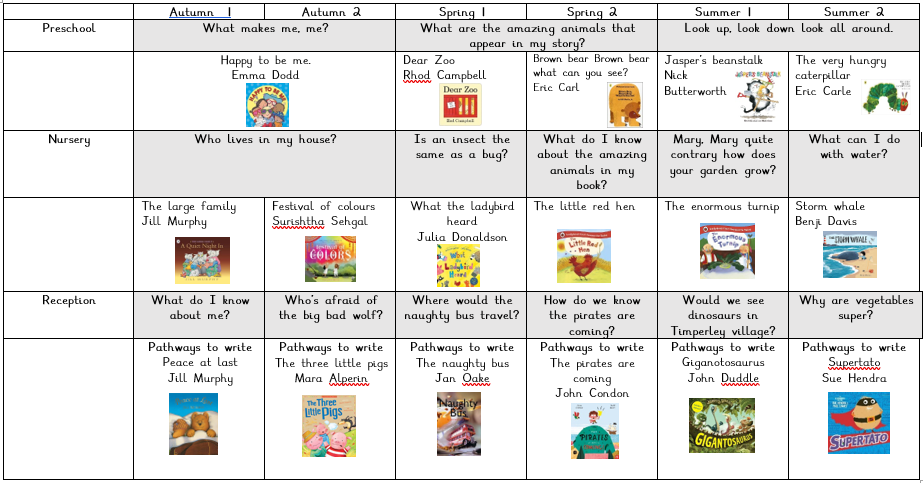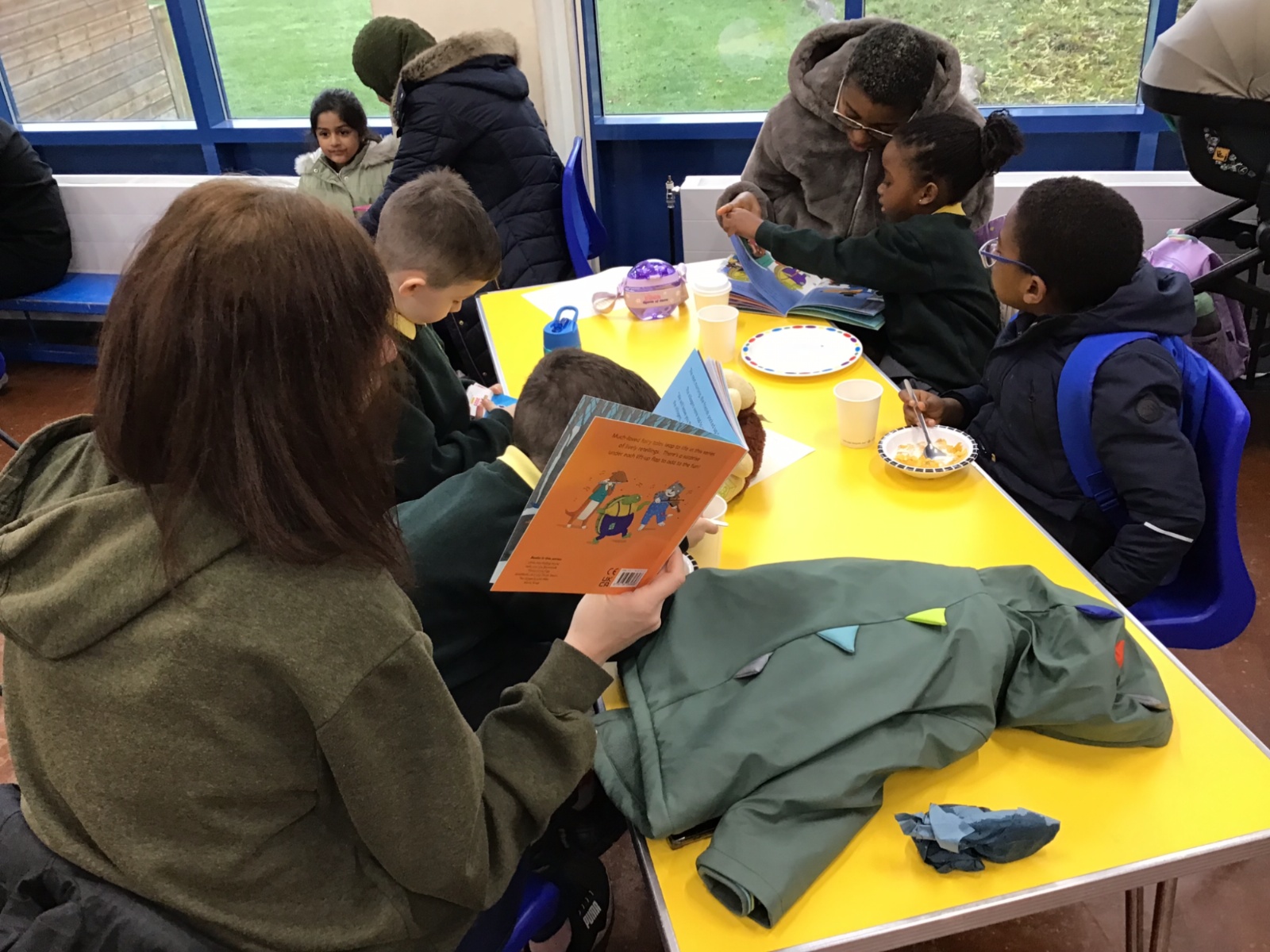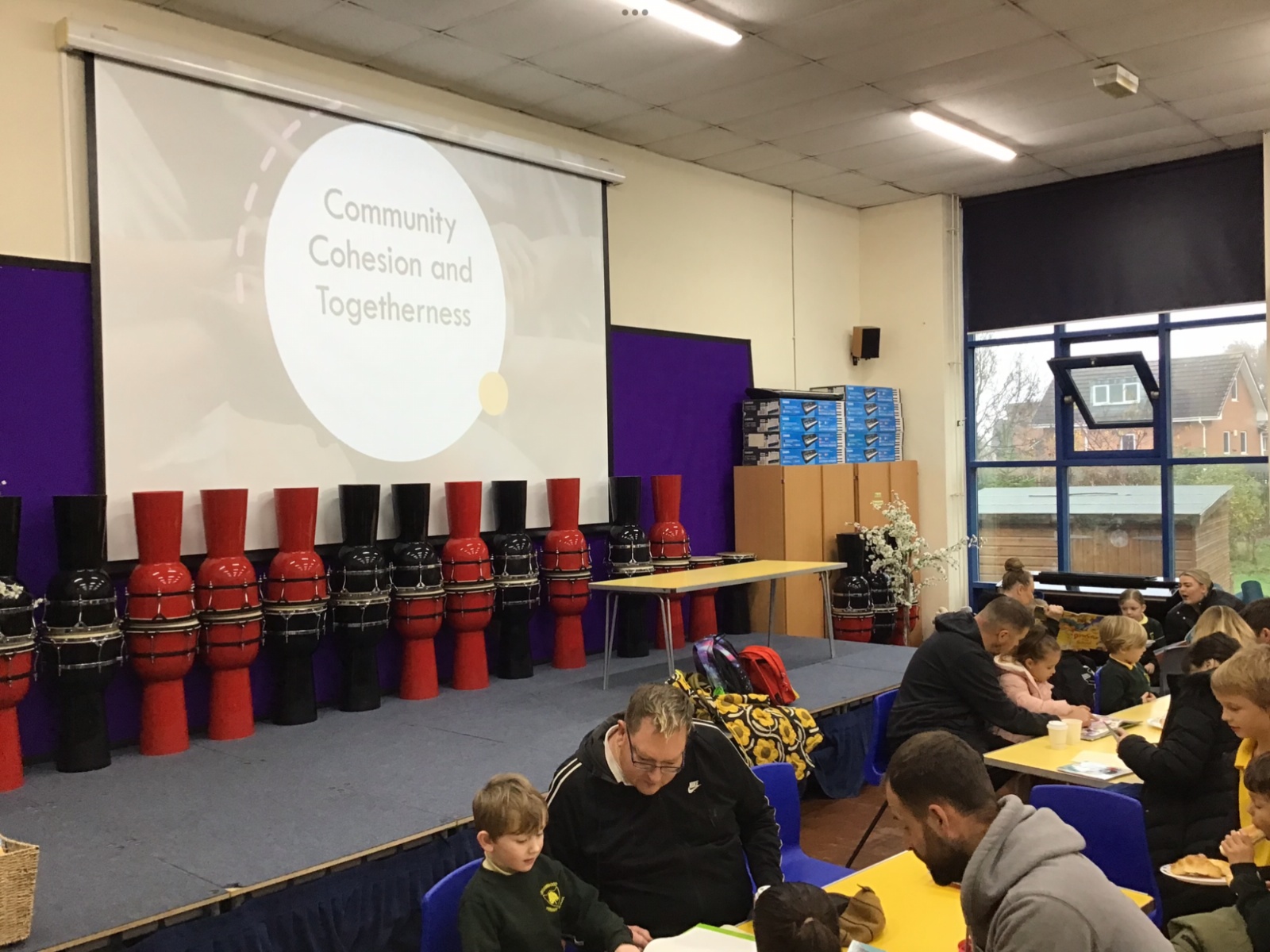Reading
At Broomwood Primary School we strive to teach the skills of reading to enable children to become confident, fluent readers who use reading as a tool to explore the wider world and further their own learning journey. We also aim to build a life-long love of literature so that throughout their lives children can use the literary world as a means of escapism, relaxation and pure enjoyment.
Intent
At Broomwood Primary School, reading begins with Early Phonics in Pre-school and Nursery.
We use the Read Write Inc scheme and show fidelity across early years and key stage 1 to deliver phonics consistently and prioritise commitment to the programme, understanding the importance of routine and repetition to support success in early reading.
When teaching guided reading in KS2, activities are taught in a specific order and set down in an example timetable. This gives teachers the flexibility to adapt the teaching to suit their class.
Implementation
EYFS
In preschool and nursery we teach early phonics skills, through a combination of whole class teaching, small groups and individual activities. We teach 7 stages.
The stages support the development matters curriculum and principles of letters and sounds which prepare children for our synthetic phonics programme Read Write Inc (RWI), which we begin the summer term of nursery.
In preschool stages 1,2,3,4 and 6 are taught.
In nursery all stages are taught across the Autumn and Spring terms. In the summer term RWI Nursery is taught, where sounds are introduced alongside the RWI materials, children learn how to say the sounds clearly and their corresponding phonemes, but do not yet write.
The stages are non -hierarchical and therefore are taught in any order, however developmentally we feel that stages 5 and 7 are more suited to nursery age children.
Stage 1 – Environmental sounds.
Children explore the sounds in the world around them, learning to listen, identify and tune into a range of everyday, animals and vehicle sounds. They learn to compare types of everyday noises. There are lots of links to listening and attention
|
Preschool |
Nursery |
|
|
Stage 2 – Instrumental sounds
Children explore the sounds that objects and instruments by exploring a range of instruments and loose parts. Children learn to tune into a range of sounds, recognise and compare as well as explore how they can change sounds, loud, quiet, bumpy, smooth, etc.
|
Preschool |
Nursery |
To use instruments and noisy objects to compare types of sounds for example loud/ quiet, slow/ fast, jumpy/ smooth. |
To describe instrument sounds/ choose appropriate words to describe the sound. Eg. Loud, quiet, quick, slow, jumpy, long. |
Stage 3 – Body percussion
Children listen and respond to sounds physically, they learn to explore the sounds they can make with their bodies through movement and how to create and keep a beat.
|
Preschool |
Nursery |
To use body percussion to make rhythmic and repetitive sounds, for example tapping knees to the beat of a song. |
Increasingly be able to use and remember sequences of patterns and movements which are related to music and rhythm. |
Stage 4 – Rhythm, onset and rhyme
Children learn a range of songs and rhymes, joining in and learning by heart. Children also explore the meaning of the word rhyme, playing with rhyming words and continuing a rhyming pattern.
|
Preschool |
Nursery |
|
Spot and suggest words that rhyme. |
Stage 5 – Alliteration
Children explore initial sounds and tune into sound patters such as a..a.. apple, astronaut, alligator.
|
Preschool |
Nursery |
|
Use print and letter knowledge in writing. For example: writing ‘m’ for mummy. |
Stage 6 – Voice sounds and syllables
Children explore the sounds they can make with their voices, copying sounds carefully and using practically in their play. Children also explore syllables by tapping and clapping out beats, listening carefully to the composition of words.
|
Preschool |
Nursery |
Explore a range of speech sounds by moving our mouths in different ways – for example using the mouth book. |
To say speech sounds carefully. |
Stage 7 – Oral segmenting and blending
Children explore how words can be broken down ‘segmented’ into smaller sounds and ‘blended’ back together. Children learn that this is a reversable process exploring how to listen to blend as well as segment words or FRED talk. Children will be introduced to Fred the frog, who can only speak in segmented words!
|
Preschool |
Nursery |
|
NA |
Segment words into their sounds using FRED talk. |
Children are taught phonics sessions daily as part of group times.
Each week children have a ‘focus’ phonic activity supported by an adult.
Our provision is carefully planned to support the development of early phonics (see environment later in the policy).
Implementation of guided/ group reading
In preschool and nursery
Children have a small group reading session once every two weeks. The book is selected by the class teacher to support the topic or an ‘essential’ read. Practitioners share a story bag with props or key words, which is used to build vocabulary as well as support the story retelling.
Book sharing is timetable daily and take place before group time at the end of each session, as an opportunity for teachers to support early reading skills and as a calm end to the morning or afternoon.
Home readers
Preschool
Parents have access to the preschool lending library which is located under the covered area at the preschool entrance. Parents are encouraged to sign books in and out.
Nursery
Children are invited to choose a book to take home from the nursery lending library and are asked to return it each week so it can be changed.
Reception
Children are provided with a reading record and 2 reading books each week. One reading book is from our reception lending library and the other is a read write in book or words that correspond to where they are in their guided reading session, following the read write inc. order of teaching. Books are changed every Wednesday.
All children in the EYFS will be given a story bag each half term as part of their week as 'focus child', these bags contain a story or book with props and successed activities to explore at home. The books and activities are carefully selected and planned to support and encourage a love of reading and enagement with books! Story bags are sent out on Wednesday and returned the following Monday.
Whole class readers
In preschool teachers will spend time each day reading with the children during book time, they will read with individuals and small groups, by the end of the year children will enjoy a whole class story time at the end of the day.
In nursery and reception children will have story time at the end of each day/ session. This could be a book chosen by a child from the reading area, or one chosen by the class teacher to support topic.
Assessment:
Preschool and nursery:
Class teachers and teaching assistants are to record observations and upload to tapestry, where the observation will be recorded as 'phonics'.
For example: Luka went to the music area and picked up a drum, he tapped on the top several times, creating a rhythmic pattern, he began to sing humpty dumpty and tap at the same time. 23.11.23 Independent learning, Phonics
The EYFS phonics and reading lead has created and will keep up to date a google document. Class teachers must record children progresses and update these records at the end of each term, autumn 2, spring 2 and summer 2.
Intervention:
Preschool and nursery
Due to the age of the children and relationship between communication, language and literacy children who are falling behind in phonics usually require support with their listening and attention. The welcomm programme is used at Broomwood to pinpoint speaking and listening needs and must be prioritised. When teachers identify children need support in communication, phonic style activities are provided alongside welcomm to learn fundamental skills that underpin early phonics. Children will receive 1 to 2 welcomm interventions per week.
Environment
The environment is one of our most valuable tools in teaching. In Broomwood Early Years the environment provides a rich and enabling space for children to pursue interests, practise and develop skills in continuous provision to support learning across the Early Years Foundation Stage Curriculum. Resources are provided both in continuous provision to support the development and application of early sound discrimination and phonic skills. Enhancements are planned by the class teacher, in areas listed below to encourage the development of a particular skill either through additional resourcing and/ or adult support.
Across our early years classrooms at Broomwood there is consistency and familairty to the environment, but areas are adapted year on year to support children progression as they move through the EYFS. Below are some recommended reads.
|
Essential books for preschool:
|
Essential books for nursery
|
Essential books for reception
|
Overview of early years texts

Read write in the foundation stage and Key stage 1
At Broomwood primary school we show fidelity to the read write inc scheme. Children begin read write inc in the summer term of nursery, through to reception and then onto key stage 1. Teachers follow the read write inc programme and children receive a daily phonics session.
We are in the process of updating this page - more information coming soon!
Home Reading
In KS1, the children have a Book Bag Book to take home which directly matches the RWI book they are reading in phonics. They are part of the same scheme and their purpose is to reinforce the learning done in school and so is matched to their phonic ability. To nurture a love for reading, children will also receive a home shared reading book that will be based on their general reading ability. This will be changed weekly when read. As children move beyond RWI phonics to RWI comprehension they transition to Accelerated Reader - the approach used in KS2.
Whole Class Readers
A carefully selected range of bocks have been identified for enjoyment in KS1. They are based on broadening the children experiences of different authors and genres as well as developing a love of reading. Some texts will be selected by children but there is a core list to ensure progression.
Assessments
RWI assessment
All KS1 children will complete a RWI assessment half termly, through the Ruth Miskin Read write inc portal, there results be used to stream groups and target children at their teaching challenge point.
Phonics Screen Check Assessments
Year 1 children, and the Year 2 children who did not pass the Phonics Screening Check, complete a practice phonics test in Autumn 1, Spring 1 and Summer 1. This is tracked by the subject lead, using the custom section of Target Tracker. Where possible, children who are not achieving the expected progress will be placed into an intervention group.
PIRA tests are also used to track children’s overall reading ability and these are reported onto Target Tracker.
Intervention
Both RWI assessments and Phonic Screening practice tests are used to identify children not meeting the expected standard. Where possible, all children below the expected standard will receive weekly intervention, as per the graduated reading approach.
Classroom environment
The sets of RWI sounds, images and sound charts are used throughout the school and should be available in classrooms. They can be in lightbulb books or on hanging displays. This is checked during environment walks.
KS2
At Broomwood Primary School our reading curriculum is designed to meet the needs of our pupils ensuring our curriculum intentions are met. We do this through;
Phonics
In Year 3, children who fell behind in the Year 2 phonics screening retake have targeted interventions to support their phonics knowledge.
Guided Reading
In KS2 we follow an approach whereby all children in the class are working on the same text but are able to access it in different ways. The books have been selected to give the children a broad reading experience across their time at Broomwood Primary with each one linking to the topics being covered where possible. Guided reading is focused on the whole class using VIPERS questions (vocabulary, inference, prediction, explain, retrieval, summary) whereby all students take part in active discussions and reading about a shared text. This happens 4 days a week, with the last session focussing on a different non-fiction text. KAGAN plays a big part in our guided reading approach where children work together to create their own ideas, predictions, and thoughts about a text and share their knowledge together. This way we can ensure all children have an active part in their learning of reading and are always supported by the class teacher and/or teaching assistant.
Home Reading
This is a vital part of our curriculum and children are encouraged to read at home at least four times a week. Children are assessed within the school and take books home matched to their reading ability using Accelerated Reader. Children select books which are matched to their secure reading ability rather than the level they are being taught at or their age or year group. Children are assessed termly as they make progress. A quiz is carried out by the child after every book read which checks their understanding.
Whole class novels
These texts have been identified for each year group to ensure that during their time in school the children are able to enjoy a wide range of genres, read to them by an adult. The curriculum has been carefully designed to ensure coverage of classical texts and texts to promote cultural and physical diversity. Enjoying a class story is so important to us that it is timetabled in for every class in the school.
Assessment
This is a vital tool for establishing the progress the children are making and for identifying the next steps in learning. In Key Stage Two, we formally assess the children each term using the PIRA tests. These give us a standardised score which we can report to parents. However, this is only one part of the picture. We also use our professional judgement when working with the children to assess where they are up to and assign a Teacher Assessment grade each half term - this is done on an assessment system called Target Tracker. Accelerated Reader also provides detailed assessment information to guide the teacher judgement.
Intervention
Using our graduated approach, we ensure that every child scoring one or more steps below expected on Target Tracker accesses phonics or reading intervention. Teachers are aware of who these children are and what interventions the children have. Please see the LKS2 and UKS2 graduated approach documents for detailed information on this.
Classroom Environment
Each classroom has a rich and engaging reading area designed to encourage and support reading for pleasure. We have an excellent variety of texts, both fiction and non-fiction with recommendations from their peers.
Graduated Reading Approach
Within reading we recognise that a small percentage of children will need more than the first quality teach in order to meet the expected standard. We have designed a graduated approach for each phase of learning to ensure that children are able to keep up and no child is missed. This also identifies how we will support our most needy children.
Impact
Reading is one of, if not the most important skill you will ever learn. It is the skill which will unlock all future learning and open up the world to you. At Broomwood Primary School, we have set up a curriculum which allows all pupils to build the necessary skills to start on that journey, our expectations are high but children are supported through our graduated approach to overcome any barriers they may face.
The impact of our reading curriculum is that the majority of children, in our school, will be able to do the following;
- decode words quickly and effectively
- develop a greater understanding of the world around them through reading and research
- use their knowledge of the world to infer meaning when reading
- enjoy reading for pleasure
- use and understand a wider vocabulary
- find inspiration and ideas for writing
- improve the structure and organisation of their writing
We believe our curriculum allows children to become life-long lovers of literature.

































.PNG)








